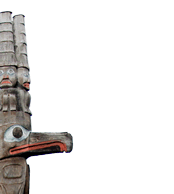 |
|||||||||
 |
|||||||||
 |
|||||||||
Songhees and Esquimalt Fishing Activities
Description
A stylized Coast Salish graphic of a person paddling a canoe comes onto the screen and stops above an introductory paragraph about marine resources, specifically fish, found in the Victoria harbour area and our dependence upon them. Various tools and fishing related implements form part of the Royal British Columbia museum collection. Photographs of fishing technology exhibits from the Songhees and Esquimalt First Nations at the turn of the 19th century are the starting point for these activities.
The fisher paddles in again to a photograph of a salmon hook used for trolling. There is a brief description of what they were made of as well as how they were used. The salmon fishing activity involves catching salmon with the hook by using your arrows to move it as animated salmon swim by. Once the time period is up, the viewer is told how many salmon they caught. Additional information as well as an archival photograph about salmon preparation, preservation, and nutrition is provided. Option to play again, continue, or exit.
The next activity is cod fishing using a fish lure or spinning shuttle-cock and a spear thrown from the canoe. A photograph of the lure is shown along with information about what they were made of and how they were used. Arrow keys are used to tilt the spear and the Space Bar is used to throw it. When the time is up, the viewer is told how many cod were caught, how cod were and are prepared, and its main nutritional makeup (i.e. protein). Option to play again, continue, or exit.
Continuing takes the viewer to a final page that briefly explains traditional and territorial fishing rights and privileges. It points out the controversy that exists as a result of differing notions and ideas about resource rights and ownership, particularly between native and non-native people.
Click HERE to go to activity
TOP of PageLearning Outcomes
Province of British Columbia curriculum samples:
Grade 10 Social Studies
Economy and Technology: Canada from 1815 to 1914
- analyse the influence of technological innovations on Canada’s economy from 1815 to 1914 (transportation, communication, fishing and other resource extraction methods)
- describe the development of British Columbia’s economy from 1815 to 1914 (identify the emergent resource-based industries in British Columbia, including: logging, mining, fisheries, agriculture)
Environment: Canada from 1815 to 1914
- Compare past and present resource development practices in BC, such as: forestry (e.g., clear-cutting, hand logging, single plank removal); fishing (e.g., spear fishing, dip-net fishing, driftnet fishing, fish farms); mining (e.g., underground mining, open-pit mining); farming (e.g., land use, industrial farming, organic farming).
- Defend a position on a selected resource development issue
Grade 11 Science and Technology
Module 5: Resource Management and Environmental Planning
- Identify resources used in B.C. and the costs and benefits of their use
- Describe the technological advances in the use and management of resources over the past 100 years
- Describe the changes in the skills required by the workforce involved in resource use and management (e.g., global positioning system, geographical information system)
- Demonstrate an awareness of the challenges faced by resource management and predict how technology might address these concerns
- Apply decision-making models to the management and use of resources
- Describe how supply and demand create stress on particular resources
BC First Nations Studies
Land and relationships I
- Analyse the relationship of First Nations people with the natural world by relating the traditional settlement and lifestyle patterns of a local First Nation to the environment
- Describe traditional BC First Nations technologies, including the uses of plants and animals
Land and Relationships II
- Compare current and traditional First Nations resource use and management
Suggestions for Use
Use as a springboard for research into local fishing history. Find out about the people and way of life in your own community. If fishing was and is not a way of life, find out about what was and is (e.g., agriculture, hunting). Trace the changes in technology used. What has been the impact of these changes?
Interview Elders (of all cultures) about fishing from their own experience and from stories they might have heard or been told.
Research non-native fishing tools and implements at the turn of the 19th century.
Research other kinds of fishing (e.g., halibut, river fishing) and the technologies used in the early 1900's.
BC Ministry of Education suggested instructional strategies for BC First Nations studies(retrieved from http://www.bced.gov.bc.ca/irp/bcfns12/lar2.htm) .
- Help students each seek out a First Nations mentor who will teach something (e.g., a traditional skill) in a traditional manner (e.g., over a month). Have students report on what and how they learned.
- Have students formulate a management plan for a particular resource (e.g., forest, land, fishery, oil, gas), taking account of a First Nations perspective and accommodating a variety of interests.
- Use video resources, written material, and guest speakers to learn about the traditional resource allocation practices and protocols of a local First Nation.
- Have students compare traditional and present-day practices related to use of game, fish, and trees (e.g., cedar roots, bark, wood, foliage). Have them relate findings to concepts of traditional ownership, sustainability, and ecology.
- Have students identify technologies, place names, and concepts that demonstrate First Nations influences.
Sample Lesson Plan - click HERE for PDF file
